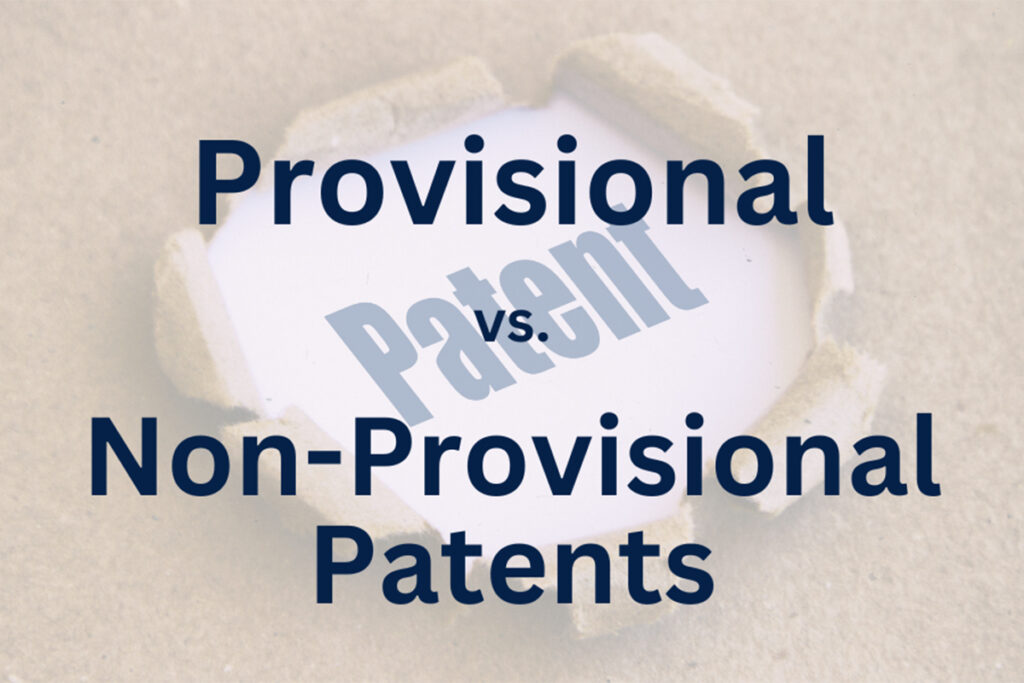
When you have an exciting new invention, all you want to do is know how to protect it from being copied or stolen.
However, deciding how to do this can often feel overwhelming. Should you file a provisional patent to get started quickly, or is a non-provisional patent better for the long term?
The first step, in any case, is to understand the differences between provisional and non-provisional patents so you can decide the best strategy for your invention.
Today’s blog will guide you through what a provisional patent is vs. what a non-provisional patent is. We’ll also give you some advice and tips on how to decide which option better aligns with your goals, budget, and business needs.
What is a Provisional Patent?
A provisional patent is a temporary patent filing that establishes an early filing date for your invention. It doesn’t turn into an issued patent on its own but serves as a placeholder. It gives you time to further develop your invention and prepare a full patent application. Working with an experienced invention patent attorney can help ensure that your provisional patent is correctly filed and that you’re well-prepared to transition to a non-provisional patent when the time comes.
Here are some benefits of a provisional patent:
- It’s Cost-Effective: Filing a provisional patent application is typically less expensive than a non-provisional one.
- The Process is Simple: You can file a provisional patent without needing formal patent claims or an oath.
- “Patent Pending” Status: Once you file a provisional patent, you can label your invention as “patent pending,” which can deter potential copycats and attract investors or partners.
- You Get Time to Refine Your Invention: One of the most useful provisional patent benefits is that it gives you up to 12 months to improve and refine your invention and decide whether to move forward with a non-provisional application.
What is a Non-Provisional Patent?
A non-provisional patent is the formal patent application that starts the examination process at the patent office. If approved, it results in an issued patent providing full legal protection for your invention.
The benefit of a granted non-provisional patent is that it offers up to 20 years of protection from the filing date. This long-term protection can prevent others from making or selling your invention.
However, non-provisional patent applications must undergo a thorough review by the patent office to assess novelty and usefulness. These applications require detailed patent claims, an oath, and an information disclosure statement. Therefore, the process may incur more costs and require more time and effort.
Provisional vs Non-Provisional: Which Should You Choose?
When deciding which type of protection to pursue, start by considering the stage of development you’re in. If your invention is still in the early stages, a provisional patent can provide protection while you refine it.
If you’re further along or have already completed developing the invention, you might want to opt for a non-provisional patent right away.
Also, take your budget into consideration. If you have limited resources, starting with a provisional patent can be a cost-effective way to secure an early filing date.
Working with an experienced intellectual property lawyer can help guide these decisions, also, think about your long-term strategy and whether you want broad and lasting protection for your invention. If you do, a non-provisional patent should be the goal.
If you’re still unsure, here are some examples of situations in which you might want to go for a provisional patent:
- You have a concept or prototype that requires further testing or development.
- You need to secure funding or partnerships and want to use “patent pending” status to attract interest.
- Your invention may evolve, and you want flexibility before filing a full patent.
Here are some situations in which you might want to go for a non-provisional patent:
- Your invention is fully developed and ready for market entry.
- You require immediate legal protection to prevent infringement.
- You have conducted thorough research and are confident in the invention’s commercial viability.
Make the Right Patent Decision for Your Invention
Choosing between provisional and non-provisional patents can feel like a big decision, especially when you’re eager to protect your invention and bring it to market. Maybe you’re thinking about how to balance costs while still getting the best protection or wondering about the best way to secure your invention’s future.
Don’t forget that there is support out there. You don’t have to know the answer to all the questions, our patent lawyers are here to help.
At The Law Office of Mario T Milano LLC, we specialize in guiding inventors through the patent process – from initial filings to full protection.
We’re here to help you understand your options and make informed decisions that align with your goals. Reach out to us and let us help you turn your invention into a protected, market-ready product.

